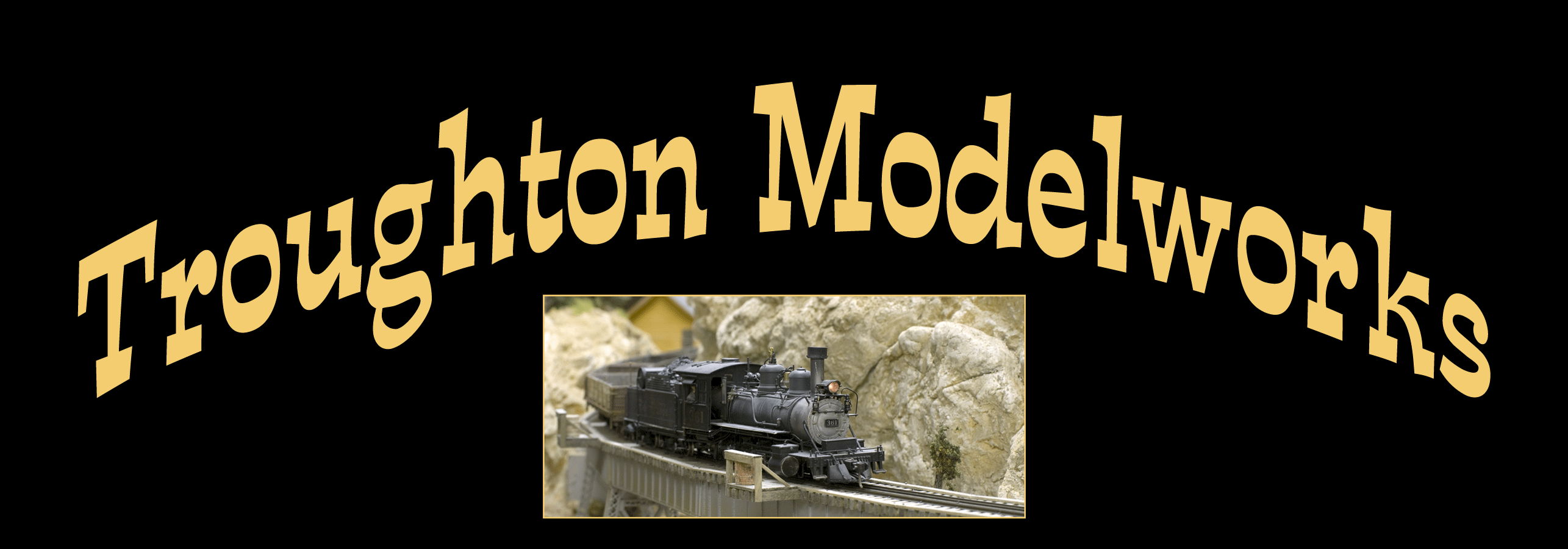

Welcome to my world of Sn3 Scale Model Railroading

Building the Engine House
at Timberline
By
Tom Troughton, MMR
| Initially, this engine house was owned by the Ponderosa Lumber Company, which was located on the Silver King Branch of my Cimmaron & Tall Timbers RR. The lumbering operation eventually cleared the surrounding mountains of usable timber and sold their holdings to the Cimarron Lead and Zinc Company for use at its Timberline Mine complex. The large ore bin and loading tracks are now served by diesel #50 or a small 2-8-0 steamer, both on loan from the D&RGW. | |
Photo 1. Here's an over all view of the engine house. The structure uses an inner supporting wall of untempered Masonite. After window openings were cut in the walls, both the inner and outer surfaces were covered with 1" x 12" strip wood that had been stained with a mixture of alcohol and black shoe dye. | Photo 2. The inside walls with their timber bracing and horizontal nailing boards are visible in this shot. The diorama base is Celotex house siding with thin slabs of pine boards added to its underside to match the thickness of the Homasote used for the surrounding tracks. The edges of the base were cut at an angle to allow it to be easily removed from the layout for additional detailing at the work bench. |
Photo 3. The interior walls are bare of hand tools, chains, hoses and the other items normally found around a engine house. They will be added later. The doors are made up of a single thickness of 1x12's" that are held together with diagonally placed 1x8's. | Photo 4. Grandt Line "O" scale Engine House hinges swivel on bent pieces of .020" music wire which were glued into holes drilled through the door framing boards. |
Photo 5. The roof is made up of two pieces of the Masonite material. The long edges were cut at an angle to allow a tight fit at the peak and also to provide a vertical lower edge. Strips of 1x10" strip wood were glued along all the exposed edges of the Masonite. Silk-span tissue paper was cut to 3' wide widths and attached with black Polly Scale paint. The 1x10's were masked off with cellophane tape and the entire roof was spray painted with Krylon, "Ruddy Brown," spray primer. It was further weathered with the alcohol & black shoe dye solution. | Photo 6. The windows are 40 pane factory units from Banta Model Works. They were spray painted with Krylon, "Ultra-Flat Black," and dry brushed with white acrylic craft paints. I used clear acetate, similar to the material found in picture framing shops, for glazing. |
Photo 7. The barrels, overhead drive belt wheels, pallets and work bench surface are metal castings from Banta Model Works. Ground cover is a mixture of real dirt from Colorado, Woodland Scenics ground foams and cinders from the C&TS, all held in place with diluted white glue. | Photo 8. The skidder is a hold over from my HOn3 modeling days. I believe it may be a Rio Grande Models piece, but I'm not positive about it's origin. |
Photo 9. The generator on the pallet is from a, "basket case," PBL K-36 boiler and the loco shop step is a laser cut wood kit by Banta Model Works. | Photo 10. The rail stops are metal castings from American Model Builders. I made the clumps of vegetation from strands of an old shag carpet. A single strand was, "flayed open," with a small steel brush, then glued into a hole drilled in the base. |
Photo 11. The log chain in the foreground is from Builders In Scale. | Photo 12. Shay #8, on loan from the WSLC is shown during the time the building was owned by the Ponderosa Logging Company. It was heading out to move log cars at the yarding area. The small water tank on the right is also from my HOn3 days. It was scratch built following plans published in a Gazette article. Even though it's small it looks good with the shay. |
Click Here To Return To Railroad Home Page